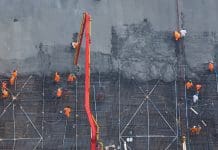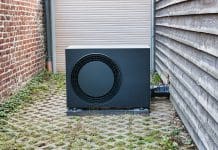How fully filling with mineral wool insulation can be the most practical and cost effective solution
When it comes to installing any form of insulation, the performance characteristics of a product must always be considered. Indeed, when approaching a masonry cavity wall application, the fire and thermal performance of the insulation, in addition to the prevention of water penetration are vital issues that must be addressed – the selection of appropriate materials and jointing methods for the outer leaf are therefore crucial.
Alongside these factors, another key consideration can be cost. Fundamentally, housebuilders and developers require high performing products that can save them time and money. With this in mind, Knauf Insulation recommends fully filling cavity walls with their DriTherm Cavity Slab. This glass mineral wool insulation is currently in the process of obtaining LABC Registered Details certification1 and carries the manufacturer’s guarantee.
These systems not only provide U-values that comply with Building Regulations, but they are also the lowest in cost. Even with dense concrete blocks it is possible to achieve very high thermal performance in a manageable wall width; and a full-fill solution is suitable for all types of buildings.
Full-fill solutions are the most commonly used in the market with approximately 55% of new build cavity walls incorporating them, and 85% of all residential cavity walls when including refurbishment.2
Housebuilders using full-fill solutions will make significant savings, whilst still achieving the thermal performance required to meet compliance with Building Regulations. In fact, compared to partial fill solutions, specifiers can save up to 50 per cent of the cost, which can equate to up to £535 per plot – a substantial cost saving for housebuilders when they are building multiple plots.
Meanwhile, mineral wool insulation products are non-combustible and classified as Euroclass A1 to BS EN ISO 13501-1 – the highest possible “Reaction to Fire” classification – compared to a D or E typically achieved by foam plastic insulation materials.
Furthermore, there is a common misconception that water can bridge the cavity and a full-fill solution cannot be used in severe exposure zones. In reality, there are mineral wool insulation products available on the market that contains a water-repellent silicone additive to ensure that no liquid water is able to pass through and reach the inner leaf of masonry. Specifiers should only choose those products that are BBA certified for all exposure zones – even when a site is being insured by the NHBC3.
Undeniably, full-fill mineral wool insulation to cavity walls offers the most practical, high performing and cost effective solution. This all helps in contributing to keeping properties warmer and for the homeowner, saving money on their energy bills in the long run. For more information please visit www.knaufinsulation.co.uk
1 Subject to final confirmation
2 Building Insulation Market, Construction Markets 2011
3 Consult NHBC Standards for guidance regarding wall construction in each exposure zone
Andrew Hale
Product Manager – New Build: Glass
Knauf Insulation Ltd
PO BOX 10
Stafford Rad
St Helens
Merseyside
WA10 3NS
Tel: 01744 766600
info.uk@knaufinsulation.com













